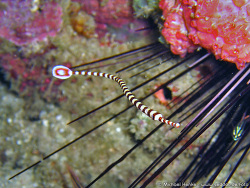Info
The banded pipefish lives a very hidden life in lagoons, tidal pools and outer reefs, mainly in caves, which it permanently inhabits together with various shrimp species and moray eels. The caudal fin of the banded pipefish is white with a red ring, or red with a white center and edge.
This pipefish is very difficult to acclimatize to food. If at all, it only eats live Artemia and/or Mysis and/or Tigriopus californicus.
However, you can now try to mix the live Artemia with dead Artemia - and then increase the proportion of dead Artemia over time, the same also applies to Mysis. In this way, it may be possible for the pipefish to eat frozen Artemia and/or Mysis.
Feeding intake.
The fish take a long time to eat at the beginning, before the food is taken up, a close inspection is carried out. After acclimatisation, the offered frozen food is eaten without problems. It should be noted that wild-caught fish behave differently than offspring when it comes to food intake. In the case of offspring, the size of the fish purchased also plays a role in the choice of food.
The shrimps that are pregnant are harassed by the pipefish or the eggs are eaten out of the lamellae.
Breeding information:
Young male pipefish need some time or mating before they carry the attached eggs to maturity.
The spawning interval* is approx. 12 days; the color of the attached eggs** indicates when the young pipefish hatch.
* The water temperature influences the number of fertilized eggs and the spawning period (with a difference of e.g. 1° C, the difference can be ± 2-3 days) and, in the case of gonochoristic (separate-sex) fish or shrimp, the sex. If the temperature is below the usual regional temperature, mainly female larvae will hatch from the clutch, above this temperature mainly male larvae will hatch. Furthermore, the aquarium conditions (e.g. light duration, density) can also influence the sex.
** The spawning size or the number of larvae depends on several factors - age and condition of the parent animals, water conditions, food quality, stress factors and the dissolved oxygen content.
Possibility of confusion: Broad-banded sea needle (Dunckerocampus boylei)
Synonymised names:
Acanthognathus caulleryi Chabanaud, 1929 · unaccepted (synonym)
Doryhamphus dactyliophorus (Bleeker, 1853) · unaccepted (misspelling)
Doryramphus dactyliophorus (Bleeker, 1853) · unaccepted (misspelling)
Doryrhamphus dactyliophorus (Bleeker, 1853) · unaccepted
Dunckerocampus dactyliophorus dactyliophorus (Bleeker, 1853) · unaccepted
Syngnathus dactyliophorus Bleeker, 1853 · unaccepted (synonym)
Direct children (2):
Subspecies Dunckerocampus dactyliophorus dactyliophorus (Bleeker, 1853) accepted as Dunckerocampus dactyliophorus (Bleeker, 1853)
Subspecies Dunckerocampus dactyliophorus multiannulatus (Regan, 1903) accepted as Dunckerocampus multiannulatus (Regan, 1903)
Feeding intake.
The fish take a long time to eat at the beginning, before the food is taken up, a close inspection is carried out. After acclimatisation, the offered frozen food is eaten without problems. It should be noted that wild-caught fish behave differently than offspring when it comes to food intake. In the case of offspring, the size of the fish purchased also plays a role in the choice of food.







 Dr. Paddy Ryan, USA
Dr. Paddy Ryan, USA

























